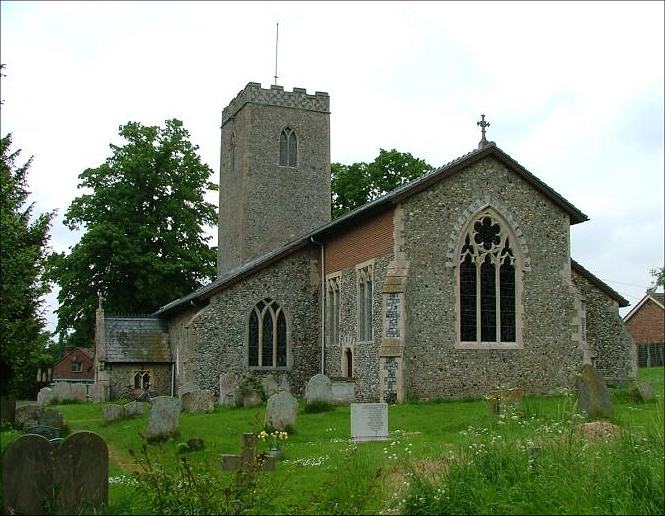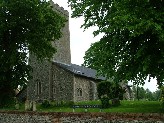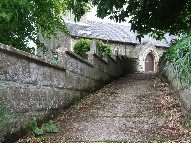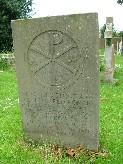| |
|
St
Andrew, Scole
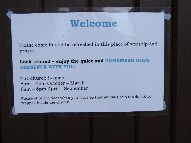 |
|
In
the days before the bypass, this church was a
familiar sight to thousands of travellers every
day. It seems incredible now, but the main roads
between Ipswich and Norwich and between Bury and
Yarmouth crossed here, to the east of Diss. The
most famous feature of the parish is probably the
large pub sign which overhangs the road. Traffic
congestion was so bad until about fifteen years
ago that frustrated drivers certainly had plenty
of time to contemplate it. A driver
looking out the other window on the seventh of
January 1963 would have had something rather more
dramatic to contemplate, for on that night the
church of St Andrew was completely destroyed by
fire.
|
The blaze
was started by an arsonist, and was pretty thorough. By
morning, all that remained were the tower, the font and
the walls up to eaves level. Work started on
reconstruction straight away, and has left something
unique in the county, an 1960s interior still redolent of
the excitements of the Festival of Britain and Anglican
post-war optimism. And there's something more: it is an
ill wind indeed that blows nobody any good, for one of
the elements of the refurbishment was a superb east
window by Patrick Reyntiens. He is most famous for the
baptistry window at Coventry cathedral, which he created
to the designs of John Piper.
I have
previously recounted the story of how, when I first came
this way in May 2005, I was refused entry. This was the
first time this had ever happened in visits to more than
1,500 churches, so it took me a bit aback, I can tell
you. I had phoned the churchwarden of the time, who made
it quite clear that the building wouldn't be opened to
visitors. I later discovered that other people had
experienced the same thing, which is obviously
unfortunate, and no way to run a parish church.
In the
couple of years, however, that had been a complete change
of heart at Scole. The Diocese of Norwich appointed an
Open Churches Officer, a European-funded initiative to
'promote and interpret' medieval churches by supporting
PCCs in opening as many churches as possible and
improving facilities for visitors. His name was Ralph
Barnett, and fortuitously he lived in Scole. At the same
time, the churches of the Scole benefice had appointed a
new and energetic Priest. It was as if a wave of renewal
was running up the Waveney Valley. Churches kept locked
in living memory except for services were making
themselves accessible. St Andrew went one better - it is
now open in daylight hours every day, with a big sign
outside to tell you so.
| We
actually met Ralph, quite by coincidence, at
Billingford, a couple of miles off, and he was
very keen that I should go back to St Andrew and
see it as it is now. And, so, we did. You climb
the long sloping path from the road, and then
open the door, and step inside. Simple as that. It is said
that nothing feels quite as old as the recent
past, and there is something in that. St Andrew's
interior is very much in the spirit of its age,
but it is an age I happen to like, because it
makes me think of my childhood. The golden
varnished wood of the roof running the full
length of the building reflects back a simple,
almost Scandinavian range of furnishings. I loved
the lattice of the organ loft, and the stark
reading desk and pulpit in the manner of a Prayer
Book church. This quietness offsets the grand
statement of Reyntiens window, which must be one
of the brashest and most glorious of its period
in the whole of East Anglia.
|
|
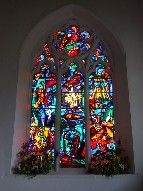 |
The window appears at first to be a complete
abstraction, but as you examine it you see that it is a
collection of scenes from the Old and New Testaments,
organised in a relatively conventional style. The central
image is the Resurrection, flanked by the Crucifixion and
the Ascension. At the bottom is the serpent and staff of
Moses, and Jonah being swallowed by a whale. Up at the
top is the Lamb of God seated on the heavenly throne. All
very dramatic.
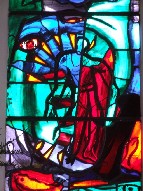  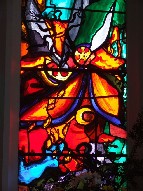 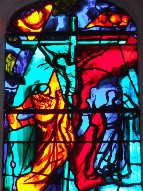 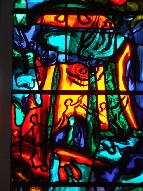
A quieter
set of images fills the east window of the south aisle,
rather more in the style of the previous decade. This
depicts the Risen Christ, flanked on one side by Mary
Magdalene meeting Christ in the garden, and on the other
by Christ and his comanions on the road to Emmaus. I
thought this window was lovely, and it offsets perfectly
the medieval font below it, rescued from the ashes of the
fire.
| A
patchwork banner on the north wall depicts
elements of the building, and was made by
parishioners to mark the 25th anniversary of the
fire. It is now almost half a century since the
arsonist struck, and the event has become part of
the history of what is the heart of a living
breathing community, a community which takes
seriously its responsibility for welcoming the
stranger and pilgrim within the gate. The
refurbishment exposed the painted splay of a
Norman window, and not far off is the Roll of
Honour, recalling that one of Scole's boys in the
slaughter of WWI was awarded the Victoria Cross.
On the pillars of the arcade opposite, graffiti
scratched over the centuries reminds us of other
parishioners of the past. Thomas Gage hid behind
one pillar and inscribed his name several times,
probably in the 17th century. You can't help
imagining that it was a dull sermon in the
twilight gloom which drove him to it. But today,
St Andrew is full of light.
|
|
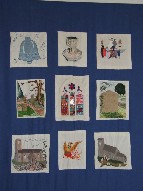 |
|
|
|

